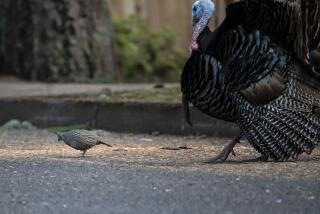Condor Chick to Learn the Ways of the Wilds : Wildlife: The captive-bred, 3-month-old bird becomes third taken to refuge north of Fillmore in an effort to teach it to fear humans.
FILLMORE — Early Wednesday, Los Angeles zookeeper Mike Clark crept silently into a nesting box where a downy California condor chick was born three months ago, covered the struggling baby vulture and carried it off.
*
Its mother, a wild bird captured in 1985, soon after the zoo’s captive breeding program first began, hissed and nervously hopped around the cage in protest as her only baby in 10 years of captivity was spirited away.
The two-foot-tall baby condor, still fluffy with down and not yet able to fly, was placed in a kennel carrier and driven in the back of a truck up a bumpy, dusty road to the Hopper Mountain National Wildlife Refuge north of Fillmore, where federal biologists hope to teach the endangered species to fear humans.
There, high on a golden hill, where the rustle of a nearby creek and the crackle of dry leaves and twigs underfoot are the loudest sounds, the chick of yet-unknown gender was placed in a small simulated cave about the size of a large doghouse with a fenced outdoor patio area. Pieces of horse meat and skinned rats were laid out on the dirt before the young bird.
But the bird, more used to the regurgitated meat that its mother provided and upset by the move, huddled inside the dark cave throughout most of the day.
“I doubt that he’ll eat much today,” Clark said. “It’s his first time away from his parents. It’s been a pretty rough day.”
The chick joined two slightly older birds kept in nearby cavettes. Those birds were transferred last month to the rugged mountains adjacent to the Sespe Condor Sanctuary--the site where the first captive-bred condors were released in 1992.
The three will be the first to participate in a type of preschool to teach them to stay in the hills and away from civilization. Biologists hope that by removing them early from the zoo, where they are exposed to the sounds of heavy equipment and human voices, they will be less accustomed to civilization and, therefore, less curious about it.
Five of the endangered vultures died after being released to the wild, three in collisions with power lines and two after eating man-made toxins. Biologists then removed the birds from the Ventura County sanctuary, judging it too close to civilization. The new preschool program marks the return of the condors to the county.
“People say the birds are really stupid,” said Marguerite Hills, deputy project leader for the Condor Recovery Program with the U. S. Fish & Wildlife Service. “But these birds were around the same time as the mastodons. How can they be stupid if they survived longer than almost any animal on Earth?”
*
At the preschool, biologists will avoid any contact with the birds, except in the aversion therapy needed to train the birds to avoid humans. Under the therapy, each time a person appears in the bird’s line of sight, a group of biologists will rush the bird, turning it upside down.
The chicks at the preschool program are the first zoo-bred condors to be raised, in part, by their parents.
A fourth chick, which will be transferred to Hopper in September, was born and reared by its parents at the San Diego Zoo.
Until now, biologists at the breeding facilities have removed the eggs from the nests well before they hatched. The idea was to encourage the adults to breed again right away, rather than wait until a chick was hatched and reared.
But with the condor population in the captive breeding program now recovered from a low of 22 to today’s 104--including three at Hopper Mountain, five in the wild, and the remaining in breeding facilities at Los Angeles and San Diego zoos and Boise, Ida.--biologists have the luxury of trying out new theories.
They now believe that in the first three months, the chicks can learn from their parents some inherent skills that may help them survive in the wild.
“Now that we have a good number of birds, we’re looking more for quality birds and not as much for quantity,” Hills said.
The next step, she said, is to bring a breeding pair of condors to the Hopper Mountain site, so the chicks can hatch and fledge, or fly from the nest, without being touched by humans.
*
But because biologists still need all the breeding pairs for the captive breeding program to ensure genetic diversity, they are not yet ready to release the adults. A special facility would have to be built that would allow a 6-month-old fledgling to fly free while keeping the parents captive.
Before the three birds at the preschool are released to the wild in a remote Santa Barbara County canyon at the end of the year, biologists plan to put them through a series of training maneuvers to teach them to stay clear of people and power poles.
There are five birds now in the wild in the Lion Canyon area of Santa Barbara County, near the agriculture community of New Cuyama. Until last week, a sixth bird was with them. All six birds had done well staying away from power poles, but one was visiting campgrounds and grew ill after campers fed it popcorn and hot dogs, Hills said. It has been returned to the zoo.
“The main thing is we do not want them to teach bad habits to the other birds,” she said.
Another group of six to eight year-old birds is scheduled for release in Santa Barbara County on Aug. 29.
More to Read
Sign up for Essential California
The most important California stories and recommendations in your inbox every morning.
You may occasionally receive promotional content from the Los Angeles Times.










